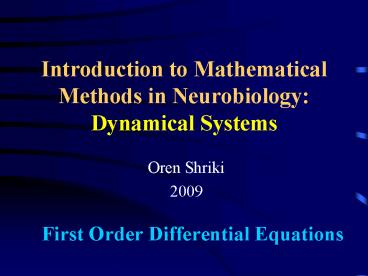Introduction to Mathematical Methods in Neurobiology: Dynamical Systems - PowerPoint PPT Presentation
1 / 29
Title:
Introduction to Mathematical Methods in Neurobiology: Dynamical Systems
Description:
First Order Differential Equations ... Dynamical Systems Two Types of Dynamical Systems What is a Differential Equation? – PowerPoint PPT presentation
Number of Views:141
Avg rating:3.0/5.0
Title: Introduction to Mathematical Methods in Neurobiology: Dynamical Systems
1
Introduction to Mathematical Methods in
Neurobiology Dynamical Systems
- Oren Shriki
- 2009
First Order Differential Equations
2
Two Types of Dynamical Systems
- Differential equationsDescribe the evolution of
systems in continuous time. - Difference equations / Iterated mapsDescribe
the evolution of systems in discrete time.
3
What is a Differential Equation?
- Any equation of the form
- For example
4
Order of a Differential Equation
- The order of a differential equation is the order
of the highest derivative in the equation. - A differential equation of order n has the form
5
1st Order Differential Equations
- A 1st order differential equation has the
form - For example
6
Separable Differential Equations
- Separable equations have the form
- For example
7
Separable Differential Equations
- How to solve separable equations?
- If h(y)?0 we can write
- Integrating both sides with respect to x we
obtain
8
Separable Differential Equations
- By substituting
- We obtain
9
Example 1
10
Example 2
Integrating the left side
11
Example 2 (cont.)
Integrating the right side
Thus
12
Linear Differential Equations
- The standard form of a 1st order linear
differential equation is - For example
13
Linear Differential Equations
- General solution
- Suppose we know a function v(x) such that
- Multiplying the equation by v(x) we obtain
14
Linear Differential Equations
- The condition on v(x) is
- This leads to
15
Linear Differential Equations
- The last equation will be satisfied if
- This is a separable equation
16
Linear Differential Equations
- To sum up
- Where
17
Example
- Solution
18
Example (cont.)
19
Derivative with respect to time
- We denote (after Newton)
20
RC circuits
Current source
- R Resistance (in Ohms)
- C Capacitance (in Farads)
21
RC circuits
- The dynamical equation is
22
RC circuits
- Defining
- We obtain
- The general solution is
23
RC circuit
- Response to a step current
24
RC circuit
- Response to a step current
25
Integrate-and-Fire Neuron
- R Membrane Resistance (1/conductance)
- C Membrane Capacitance (in Farads)
26
Integrate-and-Fire Neuron
- If we define
- The dynamical equation will be
- To simplify, we define
- Thus
27
Integrate-and-Fire Neuron
- The threshold mechanism
- For Vlt? the cell obeys its passive dynamics
- For V? the cell fires a spike and the voltage
resets to 0. - After voltage reset there is a refractory period,
tR.
28
Integrate-and-Fire Neuron
- Response to a step current
- IRlt?
29
Integrate-and-Fire Neuron
- Response to a step current
- IRgt?































